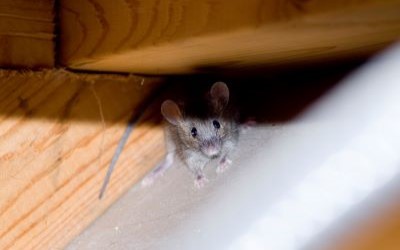
Are you concerned that there might be wildlife living in your attic? The wildlife removal and control experts at Russell’s Pest Control can help!
It’s not uncommon for various critters to find their way into this secluded space within your home. Below, we will help you recognize the signs of wildlife in your attic, how they enter your attic, what to do if this happens to you, and more.
Most Common Signs of Wildlife in Your Attic
Identifying the presence of wildlife in your attic is crucial for maintaining the safety and integrity of your home. The following signs are among the most common indicators that you may have unexpected animal guests in your attic:
- Strange Noises: Unexplained scratching, scurrying, or thumping sounds in your attic, often occurring at night, can be a clear sign of wildlife activity. Different animals may produce distinct noises, so listen closely to identify the intruder.
- Droppings and Urine: Wildlife in your attic will inevitably leave behind droppings and urine. These can vary in size and shape depending on the animal. Be cautious when dealing with droppings, as they can pose health risks.
- Damage to Property: Animals such as rats, mice, and squirrels, can be destructive. Inspect your attic for signs of damage to insulation, wiring, and structural components. Chewed wires, shredded insulation, and gnawed wood are common indicators of wildlife presence.
- Entry Points: Check for entry points that animals could use to access your attic. These may include gaps or holes in the roof, eaves, vents, or other openings. Properly sealing these openings is essential to prevent future infestations.
- Nests and Bedding: Many animals create nests in attics for breeding and shelter. Look for nests made from various materials like leaves, twigs, paper, or insulation. The presence of bedding material is a strong sign of wildlife inhabiting the space.
- Tracks and Footprints: Wildlife can leave tracks and footprints in dust or insulation. These marks can provide valuable clues about the type of animal in your attic.
- Odors: Wildlife in your attic can produce unpleasant odors due to urine, feces, and their mere presence. If you detect foul or musky smells in your home, it may be a sign of an infestation.
- Visual Sighting: On occasion, you may visually spot wildlife entering or leaving your attic. Take note of the size, color, and any distinctive features of the animals. Do not attempt to handle them yourself; contact a wildlife professional for assistance.
- Disturbed Insulation: Animals often disturb insulation when creating nests or moving around in the attic. Look for areas where insulation has been displaced or compacted.
- Daytime Noises: While most wildlife is active at night, some animals, like squirrels, may be active during the day. Listen for unusual sounds coming from your attic during daylight hours as well.
Need an Estimate for Removing Wildlife from Your Attic?
How to Remove Animals in Your Attic
If you discover wildlife in your attic, it’s crucial to prioritize both your safety and the well-being of the animals. We strongly recommend contacting a professional wildlife removal service like Russell’s Pest Control. These experts have the knowledge, tools, and experience to safely and humanely remove animals from your attic, ensuring a smooth and efficient process. Trying to handle wildlife removal on your own can be risky, so leave it to the professionals to address the issue promptly and responsibly.
How to Keep Animals Out of Your Attic
Preventing wildlife from gaining access to your attic is the most effective way to avoid the hassle and potential damage associated with infestations. By implementing the following strategies, you can make your attic less inviting to unwanted visitors:
- Regular Inspections: Schedule periodic attic inspections to identify and address any potential entry points, damage, or signs of wildlife activity. Early detection is key to prevention.
- Seal Entry Points: Thoroughly inspect your attic and roof for gaps, cracks, holes, or other openings. Seal these entry points with durable materials, such as steel mesh, foam insulation, or weatherproof sealants.
- Secure Vents and Chimneys: Install vent and chimney covers to keep animals from entering through these openings. Ensure that these covers are securely fastened but still allow proper ventilation.
- Trim Overhanging Branches: Tree branches that overhang your roof can provide a bridge for animals to access your attic. Trim them back to minimize access points.
- Install Motion-Activated Lights: Outdoor lighting with motion sensors can deter nocturnal animals from approaching your home. The sudden illumination can startle them away.
- Regular Roof Maintenance: Keep your roof maintained to prevent animals from exploiting weaknesses in the structure. Ensure that shingles and flashing are in good condition.
- Consult a Professional: If you suspect there may be entry points you can’t identify or if you’ve had recurring wildlife issues, consult with a wildlife removal expert to assess your home and provide solutions tailored to your specific situation. Here at Russell’s, we offer comprehensive wildlife exclusion services tailored to your specific needs.
Need Wildlife Removed from Your Attic? Call Us Today!
If you’re dealing with wildlife in your attic, don’t wait. Reach out to Russell’s Pest Control today for safe and effective removal. We’re experts in humane wildlife removal and prioritize the well-being of your home and the animals involved. Let us secure your attic and provide a stress-free solution. If you’re located in the East Tennessee area, give us a call now for a quick assessment and resolution of your wildlife issue. We offer free quotes!
Back to Wildlife Removal & ControlWhat Are the Signs of Wildlife in My Attic? in Knoxville TN
Serving East Tennessee since 1971